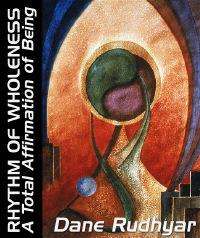 |
| Home | Bio | Art | Music | Literature | Civilization & Culture | Philosophy of Wholeness | Theosophy & Spirituality | Astrology |

RHYTHM OF WHOLENESS A Total Affirmation of Being by Dane Rudhyar, 1983 CONTENTS PROLOGUE PART ONE The Philosophy of Operative Wholeness 1. Prelude to a New Interpretation of Reality 2. The Search for Spiritual Security: The One, the Whole, and Wholeness 3. The Movement of Wholeness PART TWO The Cycle of Being 4. The Structure of the Cycle of Being 5. The Four Crucial Phases of the Cycle of Being 6. The Inevitability of Success and Failure 7. Spirit and Mind PART THREE The Cycle of Man 8. Constitution of Man - The Physical and Psychic Bodies 9. Constitution of Man - The Spiritual Entity and the Higher Mind 10. The Structure and Transformation of the Total Person 11. The Cyclic Process of Spiritual Embodiment Page 1 Page 2 Page 3 Page 4 PART FOUR In The Spirit of Wholeness 12. The Principle of Holarchy and the Interplay of Horizontal and Vertical Relationships 13. Transpersonal Activity versus Mediumship 14. Rites of Passage EPILOGUE |

CHAPTER ELEVEN
The Cyclic Process of Spiritual Embodiment - 3 The successive relationships between a spiritual Quality and a series of human persons The psychic entity surviving the death of the physical body operates in terms of collective psychism, and when communicating to living persons addresses them (via the concretizing, culture-conditioned mind of a psychically sensitive intermediary) in terms of their collective, culture-defined consciousness. However, when a person has become strongly individualized during a lifetime, the character of his or her individuality persists in the period after death. Also, the individual may have been able to reach beyond the individualistic state before dying; he or she would have performed the rite of passage at the Gate of Silence as Illumined Man, or at least as a partially illumined consciousness aware of the meaning of Wholeness, and either utterly devoted to the creative God (the One in the beginning) or self-dedicated to the service of the Pleroma, the "White Lodge" of Illumined Beings. Other possibilities more difficult to define may also occur. A human being having become a truly autonomous, self-reliant, and responsible individual person, at least mostly free from the dictates of biology and culture, has to be more or less consciously related to the principle of individualization — to the lowest of the components of the triune spiritual entity. His or her lower mind must have at least attempted to reflect the archetypal mind and to perform the dharma formulated by the latter. The ideity field must be operative, and a link must have formed to serve as a magnetic-spiritual channel of communication between the lower and higher mind and theoretically between the principle of desire (kama) and the spiritual Quality infused with divine Compassion. Even so, this link (presumably antakarana in Sanskrit) is not permanent. It can be broken temporarily or permanently if the power of some intense desire leads the person to indulge in violent or destructive acts dictated by anger, jealousy, hatred, ruthless ambition, or devastating lust. If, however, the link is strong and operative at death, all that was spirit-oriented, truly compassionate, and dharma-fulfilling during the life span is "taken up" by the spiritual entity along the channel of communication. What is so taken up represents the spiritual harvest of the personal life. It is absorbed and assimilated by the spiritual entity and becomes part of the contents of the permanent aspect of the ideity field (karana sharira), the definitive "body of individuality." In most instances, however, "something" remains in the psychic world after death. These psychic remains become increasingly subjective as time goes on — a time not measurable in objective years based on regular motions of celestial bodies (and, more recently in science, of atomic particles). This "something" is basically what is left of the energy of desire (kama). But what can desire mean in a predominantly and increasingly subjective realm in which the power of the principle of Multiplicity — the basis of relationships between diverse, objectively perceived entities — is constantly decreasing? If there are no objective relationships, there can be no objectivized forms of desire, only subjective memory experiences of desire. These "memory experiences" are as "real" as experiences in the objective, existential world. They are the kind of experiences (imperiences?) possible in the Night period of the Movement of Wholeness — in the realm of "inistence." These subjective experiences are conditioned by the objective events of physical life which they continue, as in acoustics overtones seem to prolong the vibrations of a fundamental tone. But sooner or later the memory experiences dissipate. They cease to be the experiences of a centralized personal consciousness; kama fades away, and with it what remained of the ego, the desirer. Yet the karma of the results of kama remains, because karma can be neutralized only by the performance of dharma through an activity as actual and objective as the karma-producing acts (or feelings or thoughts) of the past had been. When the sub-subcycle of being constituted by an individual person reaches its phase of greatest subjectivity — the equivalent of the symbolic Midnight, its own relative Godhead state — the spiritual entity that had sought to enter into at least partial relationship with the once-alive person is moved by Compassion (its highest and most universal aspect). To make possible the neutralization of the old karma, the spiritual entity seeks to contact a new human being yet to be born. Gradually, the archetypal structure of a new dharma is formed by the archetypal mind united with the principle of individualization (the spiritual will, Ichcha in Sanskrit). From the point of view of the spiritual Quality, the new human being's task will be to perform this dharma, but the new human being is not the old human being reappeared. It is any human being ready to be born in the biosphere whose biological characteristics could be the foundation for the performance of the new dharma. This dharma "projects" an image of itself upon the virgin etheric matter of such a human body about to be conceived — upon its "fourth ether," the level of etheric substance which reflects, and focuses karma into a particular human body. As karma is only the inverted or negative aspect of dharma, this projection of dharma is reflected in matter as karma. By this projection, the genetic pattern produced by the combination of two ancestral lines of germ cells (sperm and ovum) is altered to some extent, often considerably; the more developed the spiritual entity and its spiritual will, the greater the transformation. Only in this sense can one say that the spiritual entity "chooses" a new body; the body is selected for its possibility of adequately responding to the dharma. Because the dharma is determined by the karma of a once-living person, a cause-and-effect relationship obviously operates between the deceased person and the one being born. But to say that the former "reincarnates" in the latter is not accurate. The new person succeeds the dead one as holder of the same "office." The relation is a succession, not only because the old karma has been transmitted to the new person, but because both persons, together with many others preceding and following them, constitute a series whose successive terms are all related. They are related through a karma-dharma linkage to one single spiritual entity, one of the immense number of Letters of the creative Word, the Logos. This one single spiritual Quality — together with its servants, the spiritual will and the archetypal mind — constitutes the pole of Unity in a dynamic process whose Multiplicity pole is represented by a series of personalities periodically succeeding one another. During this process the two polarities of being interact, and the process operates two ways: the spiritual Quality "descends" toward matter and becomes increasingly differentiated, specialized, and focused; while through an "ascending" serial evolution, the many human persons participating in (and belonging to) the process achieve an increasing degree of refinement, sensitivity, and close attunement to the vibration of the spiritual Quality. Gradually, these persons increasingly come to reflect the archetypal Image spatializing the vibration of the spiritual Quality (the Augoeides in Greek mystical philosophy). The process is "consummated" in the "divine Marriage" of which mystical traditions speak — from the point of view of true occultism, in the "great Initiation."(2) The last person of the series is not only spiritualized, but in a special sense "immortalized" when the spiritual Quality becomes "impersoned" (rather than "impersonated"). As a concrete, pure manifestation of a spiritual Quality, the individualized but ego-transcending organization of consciousness and will gains the same degree of permanence as the Quality — that is, permanence until the close of the great planetary cycle. 2. In the great mythos of Christianity this consummation takes place in two scenes: one is the Transfiguration, when the Son of God (the Christos) becomes totally united with the Son of Man (Jesus); the other is the Crucifixion ("Consummatum est" — it is consummated). As the blood (the vital principle) of the Son of Man (the perfected, "christed" person) falls upon and impregnates the soil of the earth, a process of humanization of the planet symbolically begins. Thereafter, matter itself can become more responsive to spirit, to the power of divine Compassion. This occurrence heralds the coming of a future humanity, whose bodies will be finer instrumentalities allowing for a better attunement with spiritual Qualities. The recent process of the "dematerialization" of matter in the development of subatomic physics, Teilhard de Chardin's spiritualized vision of matter (see his beautiful Hymn to Matter), and the life-work of Sri Aurobindo and Mother Mira in Pondicherry, India, may be precursorial indications of an eventual planetary transformation. The negative aspect of the transformation would of course be a cataclysmic nuclear war destroying most of present day mankind. Yet if not total, such a destruction might leave a small number of positive human mutants out of whom a new species would grow (perhaps with cells or bodies more translucent to the light of spirit and dynamized by a higher vibration of the life force). Return By permission of Leyla Rudhyar Hill Copyright © 1983 by Dane Rudhyar All Rights Reserved.  Web design and all data, text and graphics appearing on this site are protected by US and International Copyright and are not to be reproduced, distributed, circulated, offered for sale, or given away, in any form, by any means, electronic or conventional. See Notices for full copyright statement and conditions of use. Web design copyright © 2000-2004 by Michael R. Meyer. All Rights Reserved. |
 |